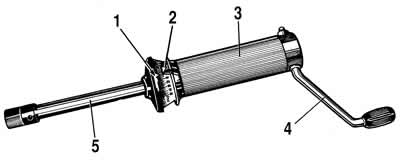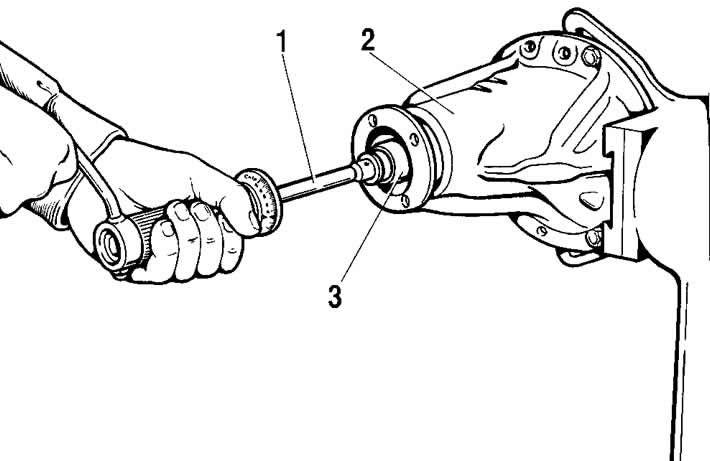
Pic. 3-69. Dynamometer 02.7812.9501:
1 - movable pointer;
2 - torque limit indicator;
3 - body;
4 - handle;
5 - rod with a tip inserted into the adapter sleeve.
The torque of resistance to rotation determines the degree of tightening of the bearings. It should be 157...196 Ncm (16...20 kgf cm) for new bearings, 39.2...58.8 Ncm (4...6 kgf cm) - for bearings after a run of 30 km or more.
It is necessary to tighten the flange nut periodically by checking with a dynamometer the moment of resistance of the bearings to turning the drive gear. In this case, the moment on the nut can be in the range of 118... 255 Nm (12...26 kgf·m).
To check the moment of resistance, install the adapter sleeve 3 on the dynamometer (pic. 3-70), set pointer 2 (see fig. 3-69) torque limit per scale division corresponding to 196 Ncm (20 kgf cm), and turn knob 4 a few turns clockwise. While turning the drive gear, the movable pointer 1 must not go beyond the pointer 2 and must show at least 157 Ncm (16 kgf cm).
If the torque is less than 157 Ncm (16 kgf cm), and for bearings after 30 km run 39.2 Ncm (4 kgf cm), then tighten the pinion flange nut (without exceeding the specified tightening torque) and check again the moment of resistance to turning the drive gear.

Pic. 3-70. Checking the preload of the pinion bearings:
1 - dynamometer 02.7812.9501;
2 - crankcase;
3 - adapter sleeve.
If the turning resistance moment is more than 196 Ncm (20 kgf cm), and for run-in bearings 58.8 Ncm (6 kgf cm), indicating that the bearing preload is too high, replace the spacer sleeve with a new one, as it has deformed from excessive load to a size that does not allow for correct adjustment. After replacing the spacer sleeve, repeat assembly with appropriate adjustments and checks.
